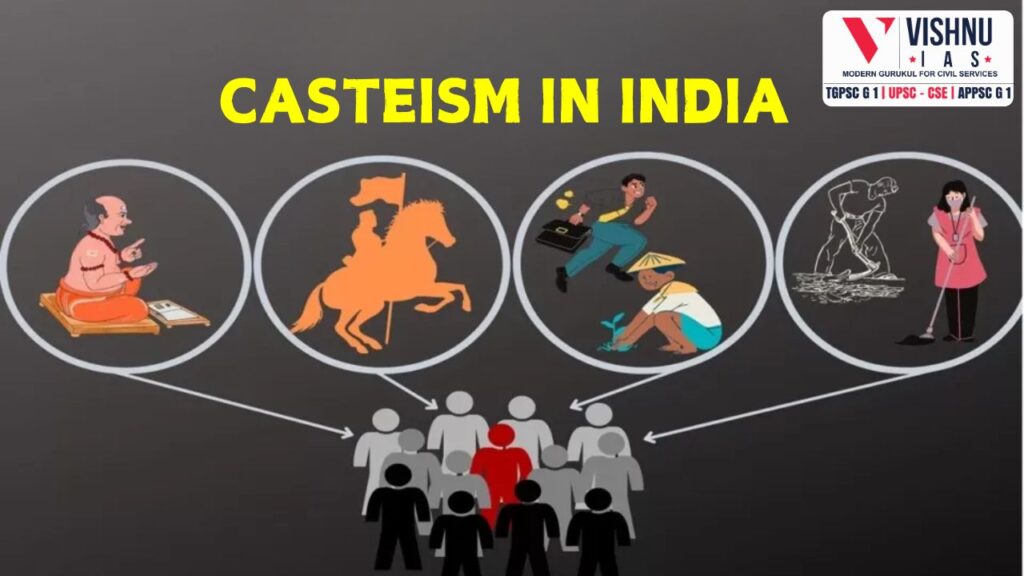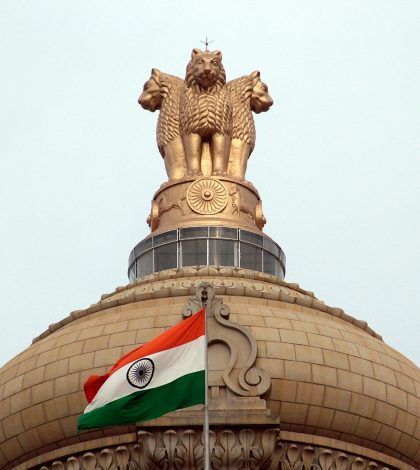INTRODUCTION CASTEISM IN INDIA
- The journey of a thousand miles begins with a single step. When Mahatma Gandhi gave the call for the Quit India Movement launched in August 1942, it energized a whole nation into taking the much-needed step toward a new horizon. At that time, it catalysed the nation into a mass movement against the British to quit India.
- The idea now is to motivate the countrymen to rise once again to the occasion by launching a similar mass movement to quit the social evil of casteism, a cause Mahatma Gandhi longed for. He described untouchability as a soul-destroying sin and declared that caste is a social evil, emphasizing that purity is of the mind and should be a matter of course for all men.
- The evil of casteism has been entrenched in Indian culture since historical times. Untouchability, exclusion of lower castes from the national mainstream, and denying them the benefits of education, healthcare, and even a place in society have stunted the growth of an entire section of the Indian population.
- Casteism is a pervasive and pernicious social phenomenon deeply rooted in historical, cultural, and religious traditions. It represents a hierarchical system that categorizes people into rigid social groups, known as castes, based on birth. Originating in ancient India, the caste system has significantly influenced social dynamics, contributing to inequality and social stratification.
Historical Analysis:
- The origins of the caste system can be traced back to the ancient Vedic period in India, around 1500 BCE. Initially, it was a division of labour and social roles, referred to as Varna, comprising four main categories: Brahmins (priests and scholars), Kshatriyas (warriors and rulers), Vaishyas (traders and agriculturists), and Shudras (laborers and service providers). Over time, these categories became rigid and hereditary, evolving into the complex Jati system, which includes thousands of sub-castes.
- Religious texts such as the Manusmriti codified and reinforced these divisions, legitimizing caste-based discrimination. The concept of purity and pollution became central, with the upper castes considered pure and the ower castes deemed impure, leading to the exclusion of the lower castes, particularly the Dalits (formerly known as “Untouchables”), from mainstream society.
- Historically, the caste system was not just a social hierarchy but also a mechanism for controlling economic resources, land, and labour. The upper castes-controlled wealth, resources, and knowledge, while the lower castes were confined to menial and stigmatized occupations.
- Colonial rule in India further entrenched the caste system by codifying and institutionalizing these divisions. The British administration used the caste system to divide and rule, exacerbating caste-based divisions and solidifying caste identities.
- The legacy of casteism persists in contemporary India, where despite legal provisions and affirmative action, the socio-economic disadvantages faced by lower-caste communities continue to reflect the historical injustices rooted in the caste system.
Political Analysis:
- The election of Ramnath Kovind, the second person from a Scheduled Caste to be elected as the President of India, could have been seen as a significant step towards establishing a polity free from the tyranny of the caste system. His ascension hinted at the possibility of an India that does not consider caste in the treatment of its citizens. However, questions remain: Was it a true reflection of the absence of social hierarchy? Sadly, the caste system continues to influence political dynamics.
- Political parties often engage in caste-based vote-bank politics, exploiting caste identities to garner support. While this provides a platform for lowercaste communities to voice their concerns, it also reinforces caste divisions and hinders the development of a more inclusive and cohesive society.
- Caste-based politics have led to the formation of numerous caste-specific political parties and organizations, further entrenching caste identities in the political landscape. These parties often cater to the interests of specific castes, leading to fragmented and polarized politics.
- The electoral success of parties with caste vote banks has spawned more such outfits whose leaders use impressionable teenagers as political capital. Distressingly, such outfits are courted by mainstream parties, perpetuating caste-based divisions in the political sphere.
- Despite attempts to address caste-based inequalities through policies and affirmative action, political considerations often dilute or inadequately implement these policies, leaving the issue of casteism unresolved.
Economic Analysis:
- Historically, lower castes were relegated to menial and stigmatized occupations, often without fair wages or opportunities for advancement. This caste-based occupational segregation has contributed to the perpetuation of poverty and inequality among lower-caste communities.
- Land ownership and control over resources were concentrated in the hands of the upper castes, leading to economic disparities that persist today. The lack of access to education and professional opportunities further entrenches these disparities, creating a cycle of poverty and marginalization.
- Many Dalits and lower-caste individuals are confined to low-paying jobs, reinforcing cycles of poverty and social exclusion. Economic mobility remains limited for these communities, exacerbating economic inequality in Indian society.
- Affirmative action policies, such as reservations in education and employment, have been implemented to address these economic disparities. However, the benefits of affirmative actions have not always reached those most in need due to implementation challenges and resistance from dominant caste groups.
- Encouraging entrepreneurship and providing access to credit and markets for lower-caste individuals are essential steps toward breaking the cycle of economic marginalization and empowering these communities.
Cultural Analysis:
- Casteism has profoundly impacted Indian society, influencing social interactions, economic opportunities, and access to education and healthcare. The rigid caste hierarchy has perpetuated inequality, restricting social mobility and perpetuating poverty among lower-caste communities.
- Social segregation is one of the most visible manifestations of casteism. Traditionally, members of different castes were prohibited from intermingling, with restrictions on marriage, dining, and even physical proximity. This segregation ensured the maintenance of social hierarchy and purity. Despite legal provisions against caste discrimination, such practices continue in various forms, particularly in rural areas.
- The cultural persistence of casteism is evident in the continued existence of caste-based rituals, customs, and traditions that reinforce caste identities and maintain social divisions. These cultural practices often go unchallenged, perpetuating the cycle of caste discrimination.
- Media and popular culture can play a role in challenging stereotypes and promoting positive representations of lower-caste communities. However, caste-based biases often seep into cultural narratives, reinforcing caste prejudices rather than dismantling them.
- Inter-caste marriages, although still met with resistance, represent a cultural shift towards breaking down caste barriers. Encouraging such marriages can contribute to social integration and challenge the deeprooted caste prejudices that have long plagued Indian society.
Social Analysis:
- Socially, the caste system continues to influence interactions and relationships, particularly in rural areas and traditional communities. Castebased discrimination and prejudice manifest in everyday interactions, marriages, and social gatherings, perpetuating social divisions and inhibiting the development of a cohesive society.
- Caste-based discrimination and violence continue to be rampant in India. Dalits and other lower-caste communities frequently face social ostracism, verbal abuse, and physical violence. Honor killings, where individuals are murdered for marrying outside their caste, are a brutal reminder of the enduring power of caste norms.
- The intersection of caste with other forms of discrimination, such as gender and religion, exacerbates the vulnerability of marginalized communities. For instance, Dalit women often face double discrimination due to their caste and gender, making them more susceptible to violence and social exclusion.
- The ‘institutional murder’ of Darshan Solanki, a young student of the Indian Institute of Technology (IIT) Bombay, reaffirms the criticism that the ruling political establishment, civil society, and mainstream media often distance themselves from the everyday tragedies and traumas of Dalit lives. This
- incident highlights the failure of institutions to address caste-based discrimination effectively.
- The shame of ‘honor killing’ thrives with a degree of social license, bypassing established laws. The recent case in Haryana, where a 17-yearold boy was taken into custody for allegedly killing his sister over an intercaste marriage, exemplifies how caste divisions continue to perpetuate violence and social injustice.
Technical Analysis:
- Technological advancements and urbanization have the potential to blur caste divides. As more children and students enter hostels and workplaces, opportunities for social integration increase, potentially weakening castebased prejudices.
- However, the paradox is that as caste has become somewhat less important in determining individual life chances due to technological and urban advancements, it has become more salient as a political identity and an institutionalized element of civil society.
- There are now caste-based educational institutions, hostels, and housing societies. While some of these play an essential role in bringing the deprived into the mainstream, they also reinforce caste identities and perpetuate social divisions.
- The use of technology in education, such as online learning platforms, can potentially democratize access to knowledge and bridge educational inequities. However, the digital divide, particularly among lower-caste communities, poses a significant challenge to achieving this goal.
- Addressing casteism through technological solutions requires innovative approaches, such as using data analytics to monitor caste-based discrimination and deploying digital platforms for social awareness campaigns promoting equality and inclusivity.
Environmental Analysis:
- Caste-based discrimination is not only a social and economic issue but also an environmental one. Lower-caste communities often live in marginalized areas with poor access to natural resources, clean water, and sanitation facilities, exacerbating their vulnerability.
- Environmental degradation disproportionately affects lower-caste communities, who are more likely to live in environmentally hazardous areas. This environmental injustice is compounded by their lack of political power and representation.
- Sustainable development initiatives must consider the social dimensions of environmental policies, ensuring that lower-caste communities have access to resources and opportunities for environmental stewardship.
- Efforts to address environmental challenges should incorporate social equity principles, ensuring that marginalized communities benefit from conservation and sustainability initiatives.
- Raising awareness about the intersection of caste and environmental issues is crucial for promoting environmental justice and ensuring that all communities have a voice in environmental decision-making processes.
Legal Analysis:
- India has implemented legal provisions to address caste-based discrimination and promote social justice. The Constitution of India, particularly Articles 14, 15, and 17, guarantees equality before the law, prohibits discrimination based on caste, and abolishes untouchability.
- The Scheduled Castes and Scheduled Tribes (Prevention of Atrocities) Act, 1989, is a significant legal measure aimed at preventing atrocities against lower-caste communities. However, the implementation of these laws remains a challenge, with incidents of caste-based violence and discrimination continuing unabated.
- Affirmative action policies, such as reservations in education and employment, have been instrumental in providing opportunities for lower-caste individuals. However, these policies face resistance and have not always reached those most in need.
- The judiciary has played a crucial role in upholding the rights of lower-caste communities and addressing caste-based discrimination. Landmark judgments, such as the Indra Sawhney case, have shaped the legal landscape of caste-based reservations and social justice.
- Legal reforms and awareness campaigns are essential to strengthening the enforcement of laws against caste discrimination and ensuring that marginalized communities have access to justice.
CONCLUSION
- Casteism, a deeply ingrained social malady, continues to affect millions of people, perpetuating inequality and social injustice. While significant progress has been made in addressing caste-based discrimination, much work remains to be done. A concerted effort involving legal reforms, education, economic empowerment, social integration, and political will is essential for dismantling the caste system and building a more equitable and inclusive society.
- By acknowledging the historical roots and contemporary challenges of casteism, and by fostering a collective commitment to change, we can hope to create a future where caste is no longer a determinant of one’s destiny.
- Hope we Indians will rise to the occasion and contribute to building a nation based on values of freedom, equality, justice, and fraternity leading to a society where all have appropriate access to livelihood, health care, education, and opportunities to develop their personality. That is the India the founding fathers of our Constitution envisaged and that we are still looking for after 70 years of independence.


